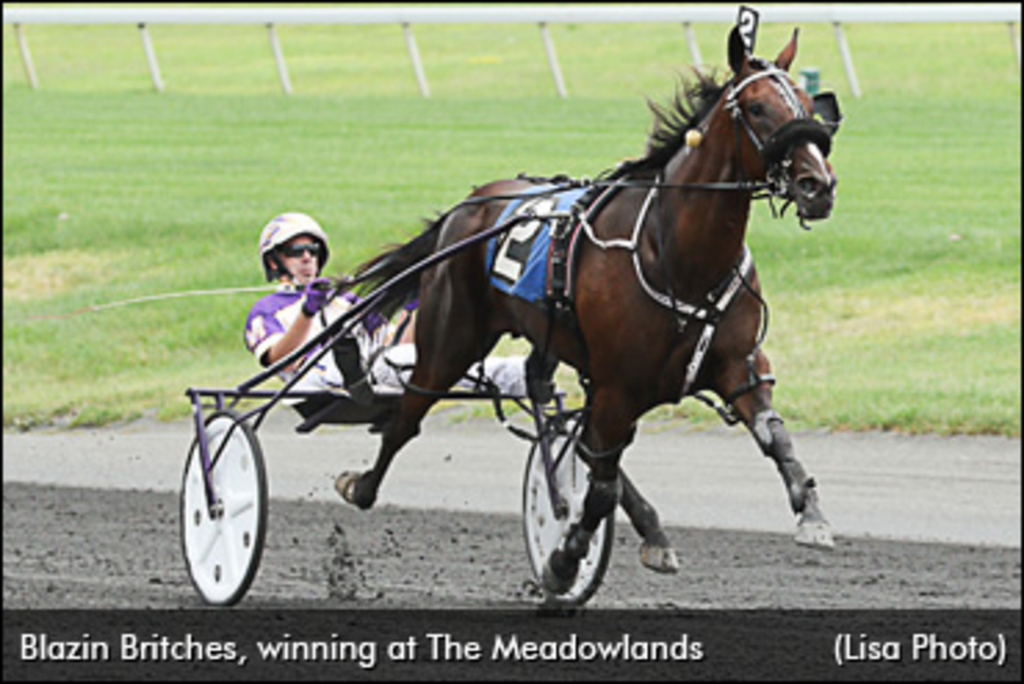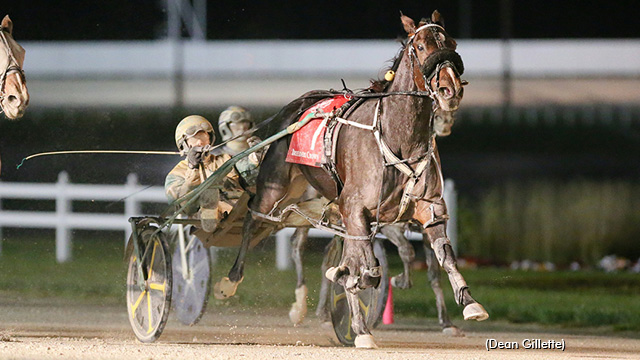
 After a successful embryo transfer, Dan Patch Award winner Blazin Britches will resume serious training in preparation for her four-year-old season.
After a successful embryo transfer, Dan Patch Award winner Blazin Britches will resume serious training in preparation for her four-year-old season.
Owned by Bruce Trogdon's Emerald Highlands Farm, Blazin Britches (Rock N Roll Heaven - Soggy Britches) won 11 of 15 sophomore starts and banked more than $540,000. The Brian Brown trainee knocked off the division's best in the Shady Daisy at The Meadowlands in addition to capturing the Nadia Lobell at Hoosier Park before capping her season with a Breeders Crown title.
Trogdon indicated last November that she was shut down after the Breeders Crown so that she could have surgery to remove a small chip from her left hock but would look to breed and race in 2018. The longtime owner has campaigned many pacing mares over the years and has extended their racing careers by choosing to perform embryo transfers.
"Years ago when I was up in Canada I did that with Maureen Rocks, Blissfull Smile, Seriously...we've done it quite often," Trogdon told Trot Insider. "It's just not very popular because it's expensive, and people don't like to buy yearlings that are embryo transplants. And I think a lot of that, personally, is because the mares -- usually -- were old mares."
In fact, Trogdon's early exposure to the embryo transfer process with renowned Canadian veterinarian Dr. Moira Gunn and her late husband, Hall of Famer Dr. Michael Colterjohn. Their early expertise and success with the process gave Trogdon the background and confidence to continue on with embryo transfers as he shifted his racing operation stateside.

"I loved doing it with Moira because she knew what she was doing. That kind of got my feet wet and now I've done it with several places. I usually just do it wherever my horses are racing."
Trogdon has a yearling stud colt from another of his star pacing mares, Jugette and Breeders Crown winner Colors A Virgin, who was still in training when she was bred and had a successful embryo transfer in 2016.
"I don't think there's anything wrong with the embryo transplant process but it depends on the luck of the draw as far as who the recipient is and all that kind of stuff. But, how many opportunities do you get? I didn't want to miss a year to get a chance to have a Fear The Dragon out of Blazin Britches," continued Trogdon. "You never know how many chances you're going to get. Every year that goes by is another chance I could get a daughter of Blazin Britches...to me, it's worth the money. And we've had really good success as far as getting them in foal. It's not that complicated, really."
While the process isn't complicated, it's neither foolproof nor inexpensive. Getting a mare to catch in and of itself can be labourious. A mare with a similar cycle must then be found, and she needs to successfully receive and maintain the embryo transplant. If this procedure doesn't work at any stage of the transfer, it must all begin again at its own pace.
"It's expensive not just because of the process, renting the mares...it costs you time. And I've had a real good success rate actually with getting them in foal but we kind of take our time, and I don't like to have them stressed," noted Trogdon. "I like to hold them up a little bit and jog them. But it gets you a little bit behind so when you start calculating the amount of time that you lose...we're skipping the $100,000 race at Miami Valley, which I'd normally go to because we're in Ohio. So you start adding that cost in, for a lot of people, it's just not worth it.
"It's a cost factor, and it does interfere...trainers don't like it if it gets messing around with their training program. But for me, if I get a Fear The Dragon out of Blazin Britches, it's going to be worth a lot. It also means I'm going to be racing her longer."

Trogdon told Trot Insider that Blazin Britches was bred in late February, an embryo was transplanted on March 2 and the recipient mare was confirmed in foal on March 9. Thus, Blazin Britches will resume a regular training regimen in preparation for a return to the track. The recipient mare was found from what Trogdon referred to as a recipient herd.
"I deal with people that are in the business of recipient herds. Generally when I give instructions to the vet and say hey, let's give this mare a shot and bring this mare in ... you normally try to give a shot to three other mares as you have to find a mare that matches up specifically in time [with her breeding cycle]. It's not as easy as 'OK, I like this mare'. Now the science is getting better and better all the time where they're getting it down pretty good.
"For me, because I'm not into the embryo transplant business, I don't have my own recipient herd -- we could, we talked about it -- you're just at the luck of the draw of which mare you're going to get. Over the years I have been disappointed several times with the mare I've got, as once it's there you're stuck with it," Trogdon laughed.
When asked what he looks for in that recipient mare, Trogdon admitted he's not as fussy on pedigree as he is on size, stature and sensibilty. He notes that some people even go outside the breed and use Belgian horses, but not him.
"Pedigree doesn't mean much. The main thing is, is it a nice, big mare that can nurse good, take care of the baby," said Trogdon. "Until you get the home, you never know. I loved dealing with Moira on this as she'd often get me a big, ol' trotting mare. Personally, I think a good Standardbred is the best mother. I worry about some that aren't big enough and a lot of times the mares I'm breeding are big and then the baby has to bend over far to nurse and that can affect the way their legs grow...there are a lot of factors, and it's not as ideal as the mother doing it herself but it's better than missing a year."

